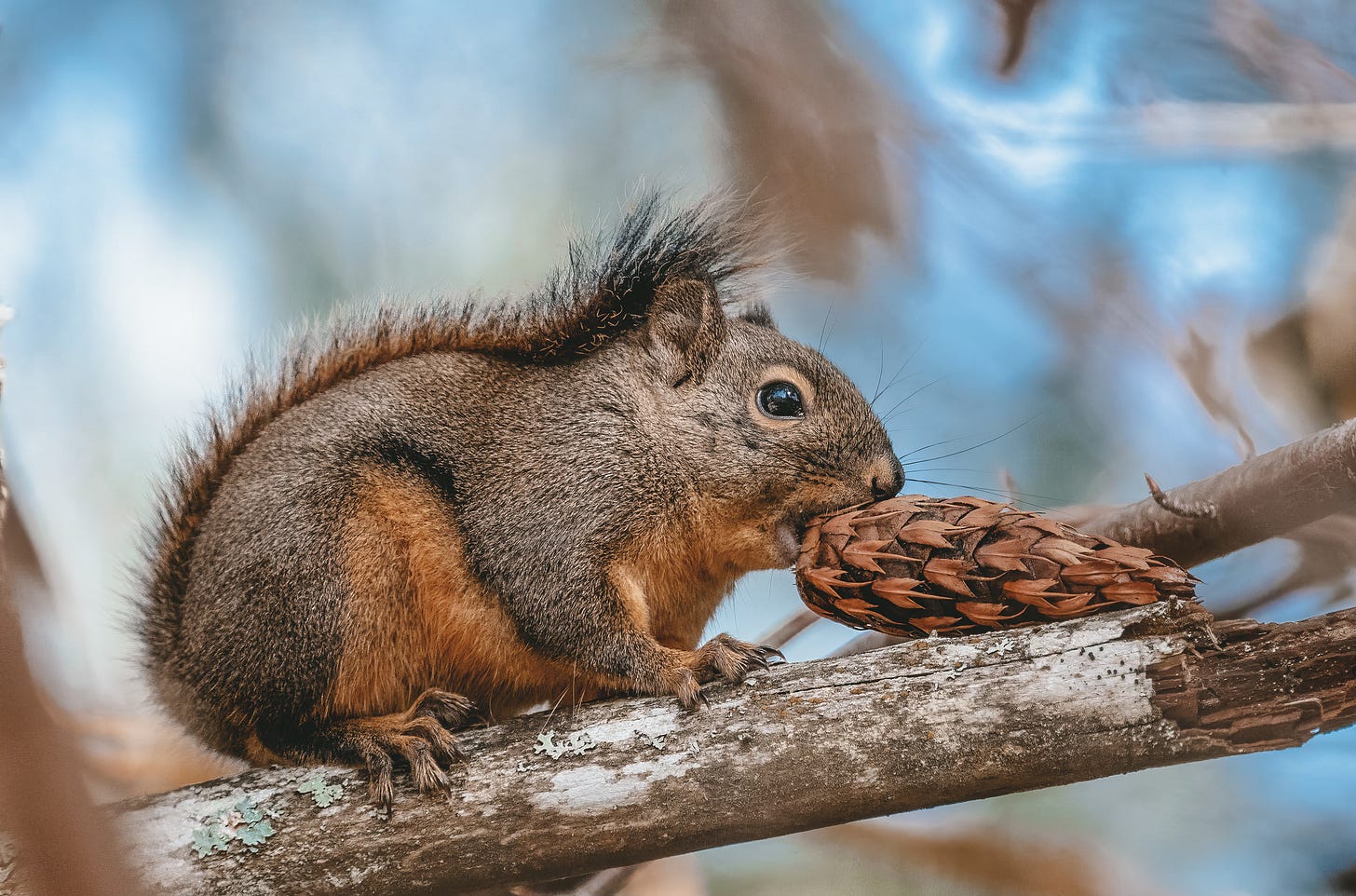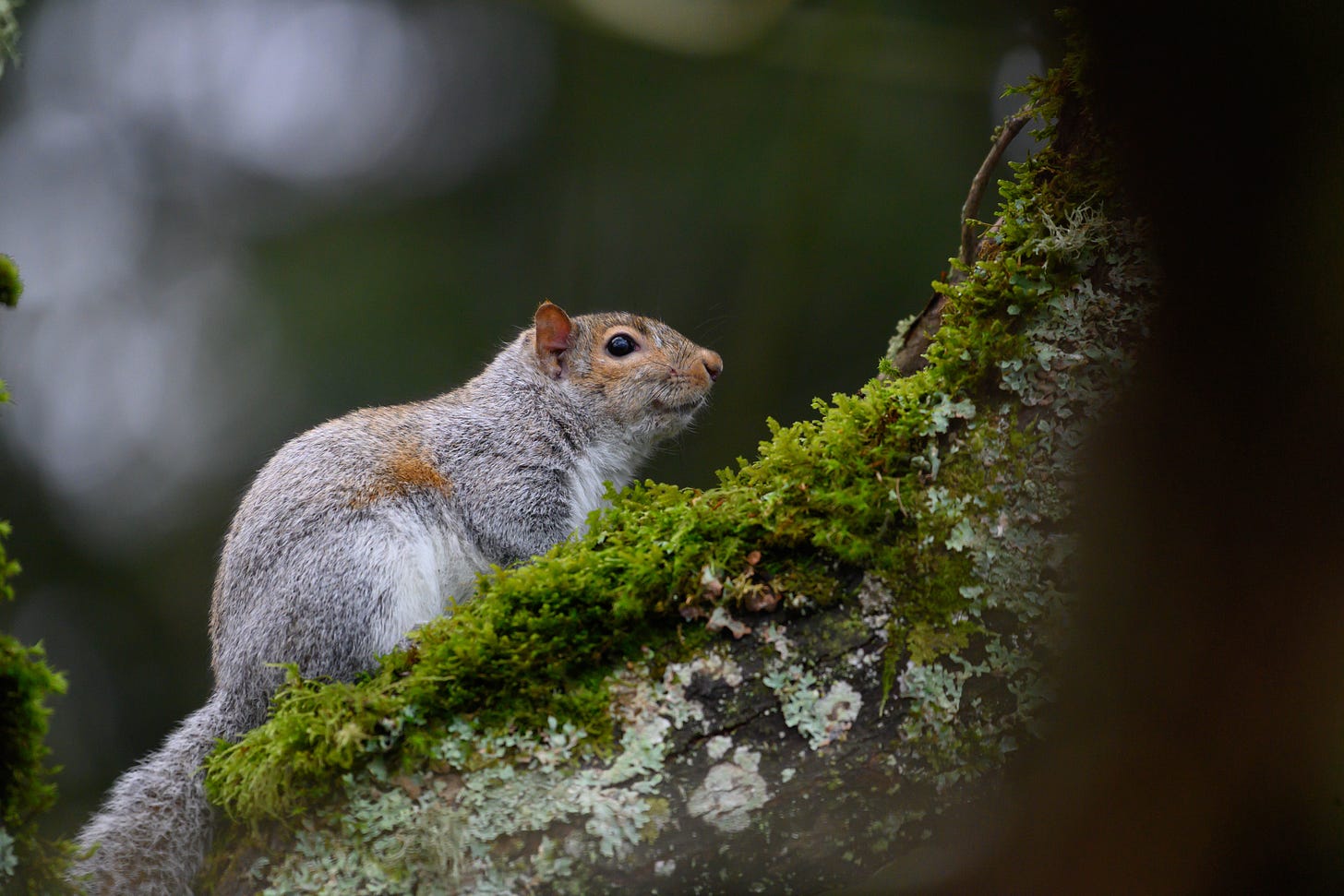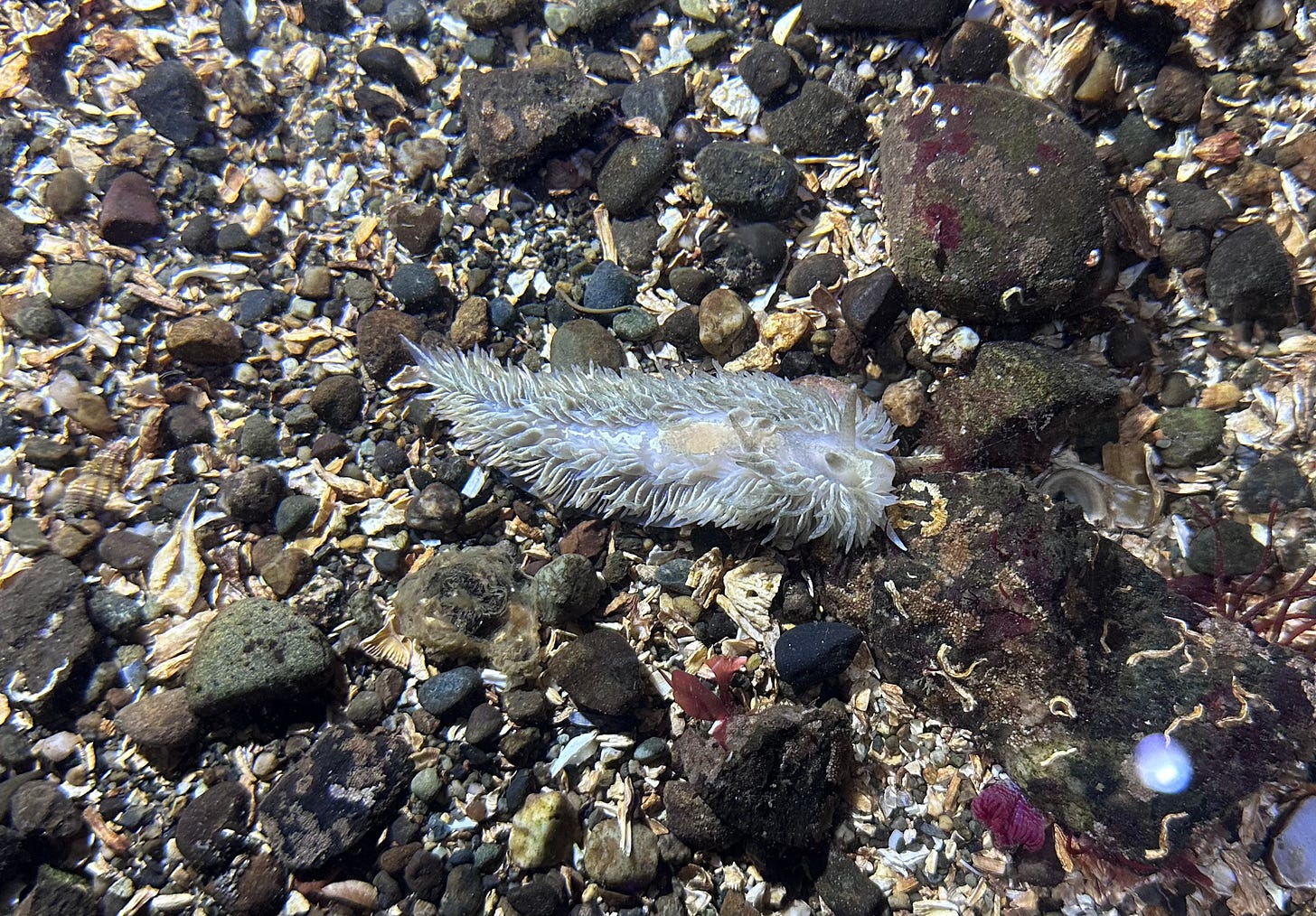Squirrels, Swimming Eagles, and Shaggy Mice
A bevy of sightings from my network of local informants
Back when I first set up shop as a community naturalist, I had this vision that I might someday have informants up and down the peninsula who could tip me off when they noticed something interesting happening in our natural world. A spy’s network of sorts.
Today that vision is just about a reality. Here are some of the more interesting reports I have lately received.
Gray Squirrels Incoming
I get a good number of questions about eastern gray squirrels. Eastern gray squirrels were released in western Washington several times in the last century to populate parks and neighborhoods. They are firmly established in the more suburban areas, and they have recently entered the Key Peninsula.
As far as ecosystems go, the eastern gray squirrel is adapted to eastern deciduous forests. Hence its comfort in the burbs. Ostensibly, there is little habitat overlap or competition between it and our beloved Douglas squirrel, the chickaree, which is a conifer specialist. In most parts of western Washington, you have one or the other.
Things are never quite so simple on our lovely little peninsula.
You have suburban next to rural, landscaped next to farmed and formerly farmed and forested, everything interpenetrating. I’ve seen eastern gray squirrels along cedar- and pine-forested wetlands. I see chickarees taking advantage of bird feeders. The two squirrels are clearly rubbing shoulders in all kinds of habitats.

Eastern gray squirrels do seem to be spreading. I want to collect more stories before I do a full write-up. Are they everywhere on the peninsula by now? Local readers, where have you seen them? Have you seen them interact with chickarees? How did the interaction go? Your stories and sightings will help me to map their exploits.
Swimming Eagles
Did you know bald eagles can swim?
Several locals have been lucky enough to see an eagle’s butterfly stroke in action.
“I saw two eagles diving on a duck,” said Bill Loyd of Home. “Finally one of them got it. It took it 20 minutes to swim that duck to shore.”
He mimed the slow stroke of the eagle’s massive wet wings. “Twenty minutes later it was on the shore. It gets up, squirrels around, gets that duck to where it can take off with it, and there it goes.”
His wife, Lynn Loyd, said seagulls harassed it all the while. “Seagulls are like policemen in the bay.”
Karen McDonell of Burley Lagoon agreed. “We always hear because the crows or the seagulls make a hoopla. The birds tell us everything.”
“We saw an eagle swimming a fish in to shore from just in front of our house. It was amazing,” McDonell said.
The eagle used its wings like oars. A seal waited just offshore to see if it might get any scraps. The eagle hopped the fish onto the beach and ate it.
At their house nearby, Bruce and Joyce Murray once got to see an eagle swimming to shore with a river otter in its talons.
This winter, local birders Faye McAdams Hands, Laurel Parshall, Melissa Sherwood, and Diane Yorgason-Quinn were on a raptor survey near Oakville and had paused alongside the Chehalis River when a bald eagle dove into the river.
“The suddenness of the drop, pretty much vertical,” Parshall said. “And then breaking the surface with the power of her wing strokes.”
The eagle set off swimming with a fish too big to lift.
“I was amazed at the distance she paddled,” Yorgason-Quinn said. “She showed no fatigue. The aura I felt from her was Determination.”
The group spied a second eagle watching from a tree above. It was smaller. They presumed it to be the swimming eagle’s mate—female raptors are a third bigger than males.
The female eagle swam among the flooded river’s root wads and log jams. “It took a moment or two to realize where she was heading,” Parshall said. “She beelined her way to a more distant gravel bar.”
“It was like watching an Olympic swimmer going for gold in the breaststroke—if they swam while holding a struggling fish as heavy as they are with their toes.”
The eagle made it to the gravel bar and stood atop the large twisting fish. Then she took a killing bite from the salmon’s throat.
Bald eagle swimming in the Chehalis River. Video by Diane Yorgasin-Quinn; all rights reserved
Shaggy Mouse Sea Slugs
Last month, Vaughn resident Justina Pritzker was exploring the low tide shallows of Taylor Bay Park with her daughter. They waded into a silty area where larger rocks were covered in aggregating anemones.
They noticed nudibranchs everywhere. There were dozens of the sea slugs. Pritzker’s daughter jumped onto her back, not wanting to step on them.
What a find! They had stumbled upon a mating group of the shaggy mouse nudibranch.
“They are one of my favorite animals to talk about because they are so unbelievably weird,” said Rachel Easton of Harbor WildWatch.
“They eat anemones and can somehow take the unfired cnidocytes (stingy cells) and pass them through their body undigested and put them on their backs to use for their own defense. It’s like eating a bowl of bees, not getting stung, and then putting the stingers on your fingers.”
Another name for this anemone eater? Shag rug sea slug. A rhyming double-spondee. What a name! And an apt description of the pile of gently waving flaps that protrude from its back.
Nudibranchs have no hard parts and are some of the most colorful creatures in the sea. There are over 3,000 species worldwide.
In our area, shaggy mouse nudibranchs like aggregating anemones best. These are the densely packed small anemones that cover low-tide boulders. When exposed to air the anemones look like slimy blobs. Underwater they unfurl green-and-pink tentacles. It is the tentacles the nudibranchs like to eat.
Aggregating anemones have the ability to clone themselves by splitting in half. If you look at one of those anemone-covered boulders, look for a narrow line of bare rock between the aggregations. This is the boundary between two groups of clones.
When a nudibranch approaches, with special mucus to repel the anemone’s stings, an anemone retracts its tentacles and column. Then it bulges its column and releases an alarm pheromone called anthopleurine. If the nudibranch persists, the anemone can crawl on its column to escape. If that fails, the anemone releases its hold and lets the water take it where it will.
A shaggy mouse nudibranch reuses not only the stinging cells from its anemone meals but anthopleurine as well. A week after a meal, its approach, leaking pheromones, can cause anemones to react defensively before they are touched. The nudibranch also picks up two types of photosynthetic algae that live symbiotically in the anemone’s tissues. These algae move into the nudibranch’s body unharmed and continue to photosynthesize. It is unknown if and how the nudibranch benefits.
I guess swimming eagles, when they use their wings like fins, are like shaggy mouse nudibranchs in that way. Sometimes as a predator you must become your prey.
Endnote
Washington has another gray squirrel with an even more delightfully bushy tail than the eastern gray: the western gray squirrel. It’s a beast of continuous oak canopy and is restricted to three small areas in Washington. The closest population is a small one at Joint Base Lewis-McChord.
Thanks for reading Infinite Peninsula. Subscribe to receive every ramble and adventure, become a paid subscriber to keep me deep in the woods, and share with anyone who would dig a spy’s-eye view of the world we share with Cascadia critters. I welcome all your hot tips.






A story about the Western Gray Squirrel at JBLM: I attended a tour hosted by the JBLM biologist. The Western Gray is a protected squirrel and efforts on JBLM are to maintain and grow the population. The squirrels were getting squished by passing cars so JBLM built a "bridge" so the squirrel could avoid the busy road. BUT....our dear local pop did not use it. The numbers kept dropping so JBLM imported a small number of the Willamette Valley Western Gray Squirrel to boost the local population and add diversity to the gene pool. Interestingly, the new boosted squirrels started using the bridge! The biologist laughed stating that maybe OR squirrels were a bit smarter than our locals. And for tree lovers JBLM has 60K acres of forest and 20K acres of plains. The plains have very old Oregon White Oak where the squirrels live. JBLM also has a stand of Ponderosa Pine that are genetically different than Pines from the East side of WA and from the OR stands. These trees are incredible and so are the Oak stands. JBLM harvest millions of dollars of timber and manages the forest lands for sustainability. If JBLM was not there it would be very likely that development would now dominate. More information on the work JBLM does to protect habitats. https://jblm.armymwr.com/application/files/6415/6692/7436/Training_Area_Map.pdf